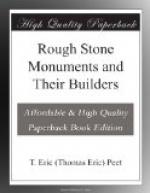These are the chief types of megalithic monument, but there are others which, though clearly belonging to the same class of structure, show special forms and are more complicated. They are in many cases developments of one or more of the simple types, and will be treated specially in their proper places. Such monuments are the nuraghi of Sardinia and the ‘temples’ of Malta and Gozo.
Finally, the rock-hewn sepulchre is often classed with the megalithic monuments, and it is therefore frequently mentioned in the following pages. This is justified by the fact that it generally occurs in connection with megalithic structures. The exact relation in which it stands to them will be fully discussed in the last chapter.
We have now to consider what may be called the architectural methods of the megalithic builders, for although in dealing with such primitive monuments it would perhaps be exaggeration to speak of a style, yet there were certain principles which were as carefully and as invariably observed as were in later days those of the Doric or the Gothic styles in the countries where they took root.
The first and most important principle, that on which the whole of the megalithic construction may be said to be based, is the use of the orthostatic block, i.e. the block set up on its edge. It is clear that in this way each block or slab is made to provide the maximum of wall area at the expense of the thickness of the wall. Naturally, in districts where the rock is of a slabby nature blocks of a more or less uniform thickness lay ready to the builders’ hand, and the appearance of the structure was much more finished than it would be in places where the rock had a less regular fracture or where shapeless boulders had to be relied on. The orthostatic slabs were often deeply sunk into the ground where this consisted of earth or soft rock; of the latter case there are good examples at Stonehenge, where the rock is a soft chalk. When the ground had an uneven surface of hard rock, the slabs were set upright on it and small stones wedged in beneath them to make them stand firm. Occasionally, as at Mnaidra and Hagiar Kim, a course of horizontal blocks set at the foot of the uprights served to keep them more securely in position. With the upright block technique went hand in hand the roofing of narrow spaces by means of horizontal slabs laid across the top of the uprights.
The second principle of megalithic architecture was the use of more or less coursed masonry set without mortar, each block lying on its side and not on its edge. It is quite possible that this principle is less ancient in origin than that of the orthostatic slab, for it usually occurs in structures of a more advanced type. Thus in simple and primitive types of building such as the dolmen it is most rare to find dry masonry, but in the advanced corridor-tombs of Ireland, the Giants’ Graves and nuraghi of Sardinia, and in the ‘temples’ of Malta




